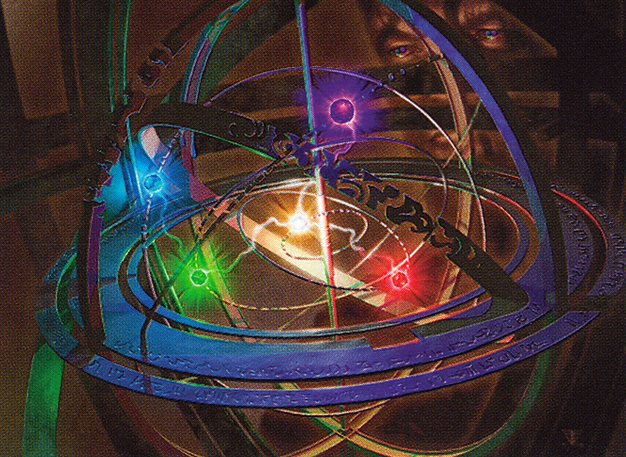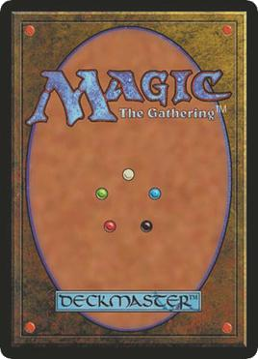 Art by Franz Vohwinkel
Art by Franz VohwinkelDesigned in the spirit of Eleusis and the Bun Magic Cube, this vintage, unpowered cube is also designed to push Magic's core strategies — aggro, midrange, and control. It features a low curve, mana fixing, and interaction of all kinds. At the same time, it makes an attempt to eschew individual game-winning bombs in favor of strategies that encourage card combinations that add up to more than the sum of their parts. Singleton has been broken in the Lands section.
Intended to be drafted in standard 3X 15 card packs, from which 40 card decks are constructed.
CUBING NOTES FOR NEWER PLAYERS
Drafting:
While no substitute for experience, when starting your cubing journey you can make certain to put together a functional deck by using KELTO to inform drafting decisions.
K - Kill Spells
Ideally low cost (two or fewer mana), instant speed, unconditional
E - Efficient Creatures
You can lose if you don't have enough two drops, but you can still win if you don't have enough five drops.
L - Lands in your Color Pair
Makes sure you can cast all of your spells on curve
T - Top End
5+ mana creatures that are game finishers
O - Other
Draw spells, enchantments, artifacts, etc.
Deck Construction and Land Count:
- Most decks play 17 land and 23 nonland cards
- Extremely aggressive decks with no cards over 3cmc might play as few as 15 lands.
- Extremely controlling decks with very few cards less than 3cmc might play as many as 19 lands.
Mixing Colors and Splashing:
- If you are new to drafting, it is recommended to draft 2 colors.
- When playing a 2 color deck it is recommended to have at least 10 sources that can produce each color. In a 17 land deck, this might look like 7 plains, 6 islands, and 4 non-basic lands that produce both white and blue.
- When splashing a single off color card, it is recommended to have at least 3 sources that can produce that color.
General Gameplay Strategy:
AGGRO//TEMPO
Aggro decks are trying to win before the opponent has the chance to fully implement their gameplan - make the focus of the game the opponent's life total. This usually takes the form of early attacking creatures combined with some form of "reach" or "final blow" to put you over the top and finish out the game. Having a critical mass of 1-drop creatures is critical to the success of this deck in order to always play a creature on the first turn of the game.
Tempo decks are also trying to win before the opponent can implement their gameplan, but rather than maximizing its "20-to-0 clock" it is leveraging disruptive elements to slow the opponent down and elongate the early developing part of the game.
example white aggro cards
example blue tempo cards
example black aggro cards
example red aggro cards
example green tempo cards
CONTROL//ATTRITION
Control decks are trying to stop the opponent from implementing their game plan, accruing card advantage, and stretching out the game into a state where they have an overwhelming advantage and can eventually win - make the focus of the game card resources and attrition. This usually takes the form of removal (counterspells, killspells, discard) combined with ways to generate value over multiple turns, drawing additional cards, and expensive but high-impact cards.
Attrition decks are also trying to stretch out the game, but rather than reacting to and trying to stop the opponent, they are more focused on proactively running the opponent out of resources.
example white control cards
example blue control cards
example black attrition cards
example red control cards
example green attrition cards
MIDRANGE//SYNERGY
Midrange decks are trying to split the difference, making the game about resources when playing against an aggressive deck, and putting the opponent on a clock when playing against a controlling deck. This strategy can take many forms but almost always has a some combination of threatening creatures, flexible removal, and card advantage//value-generation.
Synergy decks are also almost always acting in a flexible role between aggro and control. However, rather than playing the most individually powerful cards available, these decks rely on synergies between otherwise less-powerful cards to create an outsized threat or card advantage. These synergies can vary from mild advantage to instantly winning the game.
a few example "more than the sum of their parts" card combinations:
Draw two additional cards per turn
Create infinite angels
Deal 2,4,6,8,10 damage on consecutive turns
Draw lots of cards
Deal 10 damage
Generate lots of 5/3 creatures
Force the opponent to sacrifice every turn
Sacrifice creatures for 2 damage each
Play cards off the top of the library without getting stuck on consecutive lands
Increase the value of all token makers
Happy Cubing!

